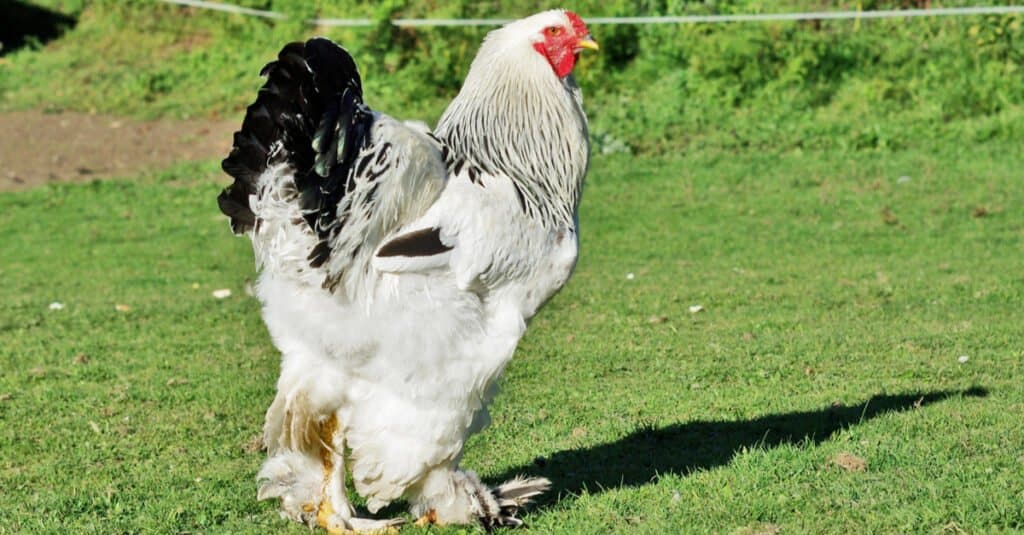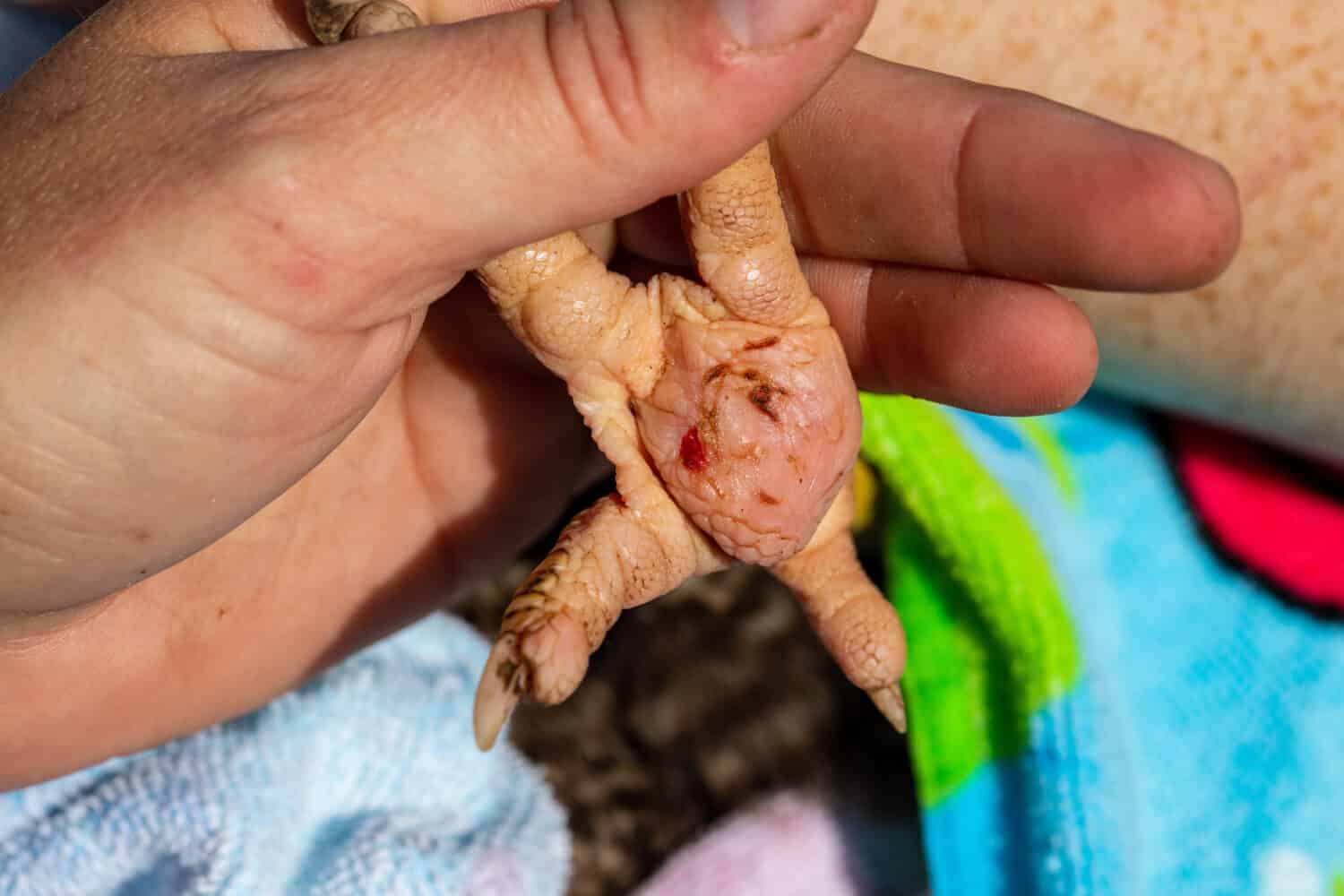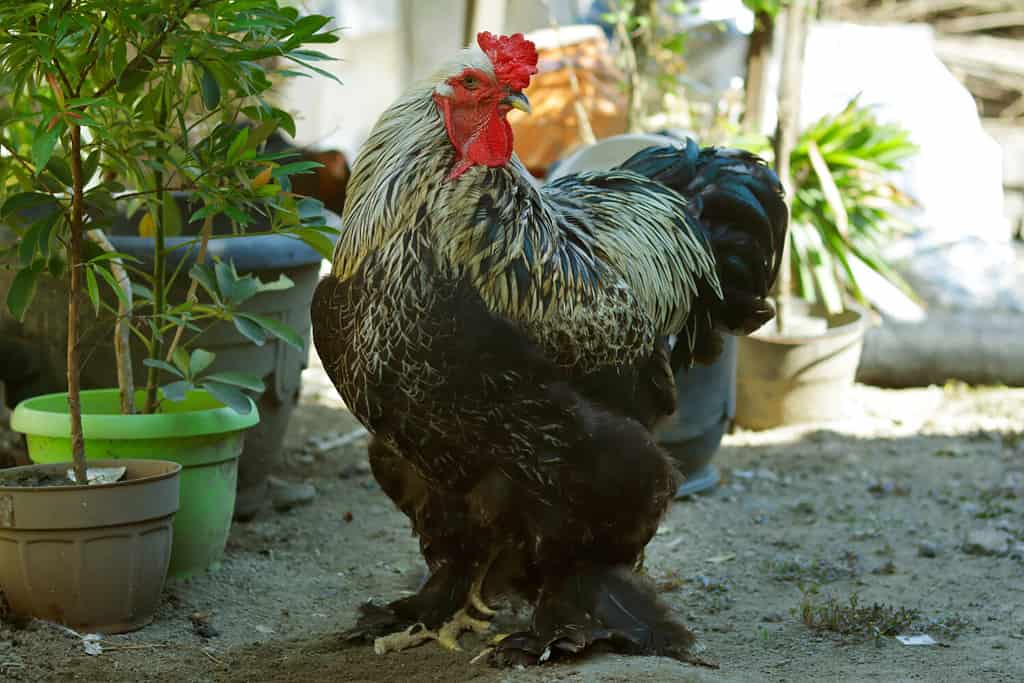Originally named the Brahmapootra after the Brahmaputra River, what we know today as the Brahma chicken breed has a rich history as a meat, egg, and even pet breed both in the United States and worldwide. If you already own your flock or are considering starting one, you’ve likely heard of this popular and well-loved breed at some point. Are you thinking of integrating a few Brahmas into your backyard brood? If so, keep reading for everything you should know about the breed, its history, appearance, egg-laying, temperament, care needs, and much more!
Get to Know the Brahma Chicken: A Brief History of the Breed

Today, Brahmas are available in several color variations, with the most common being light, dark, and buff.
©Patri Sierra/Shutterstock.com
The Brahma chicken wasn’t always known as the Brahma. There’s a lot of debate regarding its exact origins, but most historians agree the breed was developed in the United States in the 1840s using chickens imported via the port of Shanghai, China.
Although three main color variants exist today, the original was the light Brahma. Its overall appearance has remained mostly the same since its inception: a large, stocky bird with a pea-shaped comb, mostly white plumage, heavily feathered legs, and rather ornate dark markings around the neck, wings, and tail feathers.
Early in its development, many options were suggested for the breed’s official name. In 1852, a group of poultry show judges gathered in Boston, Massachusetts, to discuss its formal naming moving forward.
Initially, the judges decided on “Brahmapootra,” likely after the Brahmaputra River flowing through Tibet, northern India, and Bangladesh. The river isn’t far from the origins of the gray Chittagong birds used in the Brahma’s early development. Eventually, “Brahmapootra” became “Brahma,” and the name stuck.
Around the same time, in 1852, the Brahma made its way to the United Kingdom when poultry breeder George Burnham gifted nine of his own “gray Shanghaies” to Queen Victoria. From these nine birds, the dark Brahma variant was developed and subsequently re-exported to the United States. The buff variant was developed later and wasn’t formally recognized within the breed standard until the 1920s.
Originally, the Brahma was chiefly utilized for its meat due to its large size and hardiness. It was the primary meat breed in the United States until around the 1930s. Today, it is a popular choice for both its meat and eggs and, increasingly, as a pet amongst hobby farmers.
Brahma Appearance: Size, Weight, Color, Etc.

The Brahma’s distinctive pea comb gets its name from its bumpy appearance which makes it look like a small row of peas.
©Octopus16/Shutterstock.com
Brahma chickens are easily recognizable thanks to three main traits: the dense plumage on their legs and feet, their uniquely pea-shaped combs, and their large, bulky build. To be clear, the breed’s distinctive “pea comb” gets its name from how its bumpy shape looks like a row of peas.
Though Brahmas are now available in several color variations, they all have the same overall appearance and similar dark, small stripe-like markings on their necks, wings, and tail feathers. The most common color variants are light, dark, and buff, which are pretty straightforward: the light variety is mostly white with black markings, the dark variety is mostly gray with black and white markings, and the buff variety is a creamy, golden-brown tone with dark brown and black markings.
Although Brahma chickens are very large when fully grown, their growth rate is slower than that of most other chicken breeds. The average weight of a male Brahma cockerel at around one-year-old is between 10 and 12 pounds. Meanwhile, hens are slightly smaller at 8 to 9.5 pounds. It typically takes around 10 to 18 months for a Brahma to reach its full adult size. Especially large individuals can reach weights exceeding 15 pounds, though this is fairly rare.
Brahma Temperament and Personality: What to Expect
Despite its large, rather imposing size, the Brahma is a gentle giant when it comes to its overall temperament. In general, it is friendly, hardy, and approachable and does not tend to be flighty or skittish. This makes it a popular choice for beginner hobby farmers keeping chickens as pets, particularly those with small children interested in getting hands-on with their flock.
Furthermore, Brahmas are highly intelligent, curious, and inquisitive birds that will forage and explore as much land as you provide to them. However, they are also very docile, slower than most other breeds, and do not fly well thanks to their large build. This makes them easy to contain in a backyard enclosure.
Notably, rooster-to-rooster aggression is usually not an issue with Brahmas thanks to the breed’s calm, non-confrontational temperament, which is present in both male and female Brahmas.
Brahma Chicken Lifespan: How Long Do They Live?
The average lifespan of a Brahma chicken is between 5 and 10 years. However, this is merely a general estimate, as their exact lifespan can vary depending on the quality of their diet and care, as well as their genetics. Especially long-lived Brahma birds can reach 12 years or more, though this is fairly rare.
In general, large-breed chickens tend to have slightly shorter lifespans than smaller breeds. However, despite being a large breed, the Brahma is hardier than most and has an overall average lifespan compared to most chicken breeds.
Because they grow and mature more slowly than most breeds, Brahma hens often don’t begin laying eggs until they are around 6 to 9 months old. They stop laying at around 5 to 8 years of age.
Brahma Care Requirements and Health Issues

Bumblefoot, or plantar pododermatitis, is common in breeds like the Brahma with dense plumage around the legs and feet.
©Chad Robertson Media/Shutterstock.com
In general, the Brahma’s care needs are similar to those of most other chicken breeds. However, there are a few special considerations to keep in mind due to the breed’s large size and slow growth rate. For starters, they require more space to roam and socialize. They also need more food than smaller breeds, as well as larger nesting boxes and more room to roost inside the coop.
Another important factor when it comes to the Brahma’s size is how poorly it fares in very hot and/or humid weather. Its thick, dense plumage is perfect for chilly winters and trekking through snow. In the summer, though, its large, heavy feathers make it harder to cool down. To keep your flock cool, make sure your Brahmas have plenty of shaded, sheltered spaces and access to cold, fresh water during the hot summer months. Additionally, you’ll need to ensure your birds’ coop is spacious and well-ventilated.
As far as health issues go, Brahma is healthy and exceptionally hardy. However, its thick plumage, especially around the legs and feet, can present an opportunity for parasites like lice and mites. Providing your flock with access to a dust bath, ideally with diatomaceous earth, can help prevent these parasites.
Also due to their larger size and larger feet, Brahmas are more prone to plantar pododermatitis, better known as bumblefoot. This inflammatory condition is the result of a staph infection and causes swelling, redness, and abscesses around the bottoms of the feet, as well as visible limping. In many cases, you will need to clean the affected foot and treat it with a solution recommended or supplied by your vet, likely an antiseptic to kill bacteria.
Brahma Chicken Eggs: Color, Size, Frequency, Etc.
Although they are best known as a meat breed, Brahma chickens are also quite robust layers of large, brown eggs. However, as we touched on earlier, they also mature more slowly than most breeds. This means most Brahma hens don’t begin laying until around 6 to 9 months of age. Furthermore, they tend to lay somewhat infrequently or sporadically until they are around one year old.
At around 12 to 16 months old, though, most Brahma hens begin to lay more consistently. On average, a Brahma hen will lay between 130 and 150 eggs per year, or around one egg every two to three days. Their large, brown eggs typically weigh 55 to 60 grams, or roughly two ounces each.
Brahma Chicken Breed Summary: Overall Pros and Cons

If you can accommodate the Brahma’s large size and care needs, it can be a rewarding member of your backyard flock.
©Klimiz/Shutterstock.com
In short, the Brahma is an excellent dual-purpose breed that also makes a great, hardy backyard companion. These birds thrive especially well in cooler climates, though they can also do well in warmer areas if they have access to plenty of shade, shelter, and cold, fresh drinking water. Their calm, gentle, yet curious and intelligent personalities mean they get along well with children and most other chicken breeds, as well as other pets and livestock.
On the flip side of this, Brahmas require more space, more food, and larger nesting boxes than most other breeds due to their large size. In addition, their thick plumage can make them unwitting hosts to skin parasites, and their feet are especially vulnerable to infections like bumblefoot. If you’re excited about raising your birds for eggs, keep in mind you may have to wait a few more months than usual with your Brahmas, as they mature more slowly than other breeds.
All things considered, the Brahma is an exceptionally rewarding, worthwhile breed if you can provide it with a bit of extra TLC and meet its care needs appropriately.
The Brahma At-a-Glance
| Average Weight | 8-12 lbs (8-9.5 for hens, 10-12 for cockerels/roosters) |
| Egg Color and Size | Light to dark brown; large eggs, 55 to 60 grams |
| Average # Eggs Per Year | 130 to 150 |
| Temperament | Gentle, calm, docile, curious |
| Average Lifespan | 5 to 10 years |
| Main Color Variants | Light, dark, and buff |
| Key Traits | Large body size, feathered legs, and feet, dark markings on neck, wings, and tail feathers, small head, and comb |
| Comb Shape | Pea comb |
The photo featured at the top of this post is © Patri Sierra/Shutterstock.com
Thank you for reading! Have some feedback for us? Contact the AZ Animals editorial team.






